Peugeot 301 2017 Manual PDF
Manufacturer: PEUGEOT, Model Year: 2017, Model line: 301, Model: Peugeot 301 2017Pages: 306, PDF Size: 9.87 MB
Page 71 of 306
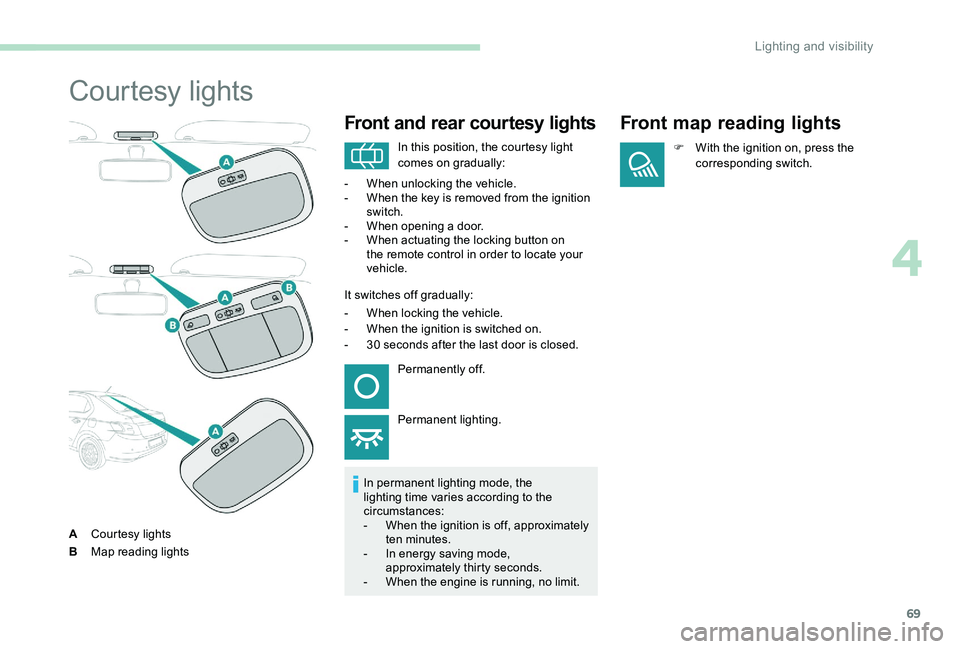
69
Courtesy lights
ACourtesy lights
B Map reading lights
Front and rear courtesy lights
In permanent lighting mode, the
lighting time varies according to the
circumstances:
-
W
hen the ignition is off, approximately
ten minutes.
-
I
n energy saving mode,
approximately thirty seconds.
-
W
hen the engine is running, no limit.
Front map reading lights
F With the ignition on, press the corresponding switch.
In this position, the courtesy light
comes on gradually:
-
W
hen unlocking the vehicle.
-
W
hen the key is removed from the ignition
switch.
-
W
hen opening a door.
-
W
hen actuating the locking button on
the remote control in order to locate your
vehicle.
It switches off gradually:
-
W
hen locking the vehicle.
-
W
hen the ignition is switched on.
-
3
0 seconds after the last door is closed. Permanently off.
Permanent lighting.
4
Lighting and visibility
Page 72 of 306
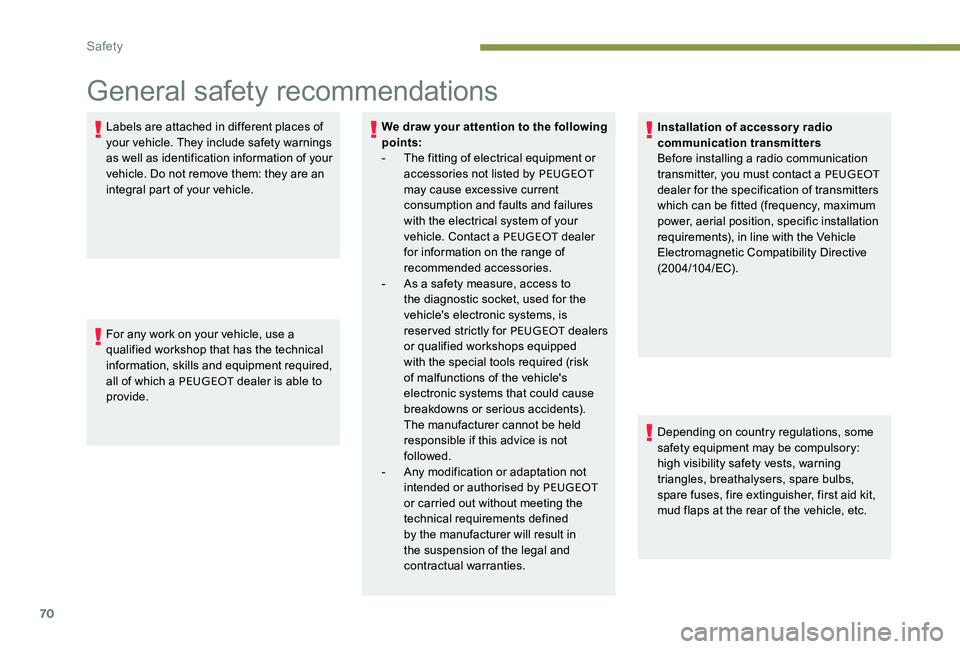
70
General safety recommendations
Labels are attached in different places of
your vehicle. They include safety warnings
as well as identification information of your
vehicle. Do not remove them: they are an
integral part of your vehicle.
For any work on your vehicle, use a
qualified workshop that has the technical
information, skills and equipment required,
all of which a PEUGEOT dealer is able to
provide. We draw your attention to the following
points:
-
T
he fitting of electrical equipment or
accessories not listed by PEUGEOT
may cause excessive current
consumption and faults and failures
with the electrical system of your
vehicle. Contact a PEUGEOT dealer
for information on the range of
recommended accessories.
-
A
s a safety measure, access to
the diagnostic socket, used for the
vehicle's electronic systems, is
reserved strictly for PEUGEOT dealers
or qualified workshops equipped
with the special tools required (risk
of malfunctions of the vehicle's
electronic systems that could cause
breakdowns or serious accidents).
The manufacturer cannot be held
responsible if this advice is not
followed.
-
A
ny modification or adaptation not
intended or authorised by PEUGEOT
or carried out without meeting the
technical requirements defined
by the manufacturer will result in
the suspension of the legal and
contractual warranties. Installation of accessory radio
communication transmitters
Before installing a radio communication
transmitter, you must contact a PEUGEOT
dealer for the specification of transmitters
which can be fitted (frequency, maximum
power, aerial position, specific installation
requirements), in line with the Vehicle
Electromagnetic Compatibility Directive
(2004/104/EC).
Depending on country regulations, some
safety equipment may be compulsory:
high visibility safety vests, warning
triangles, breathalysers, spare bulbs,
spare fuses, fire extinguisher, first aid kit,
mud flaps at the rear of the vehicle, etc.
Safety
Page 73 of 306
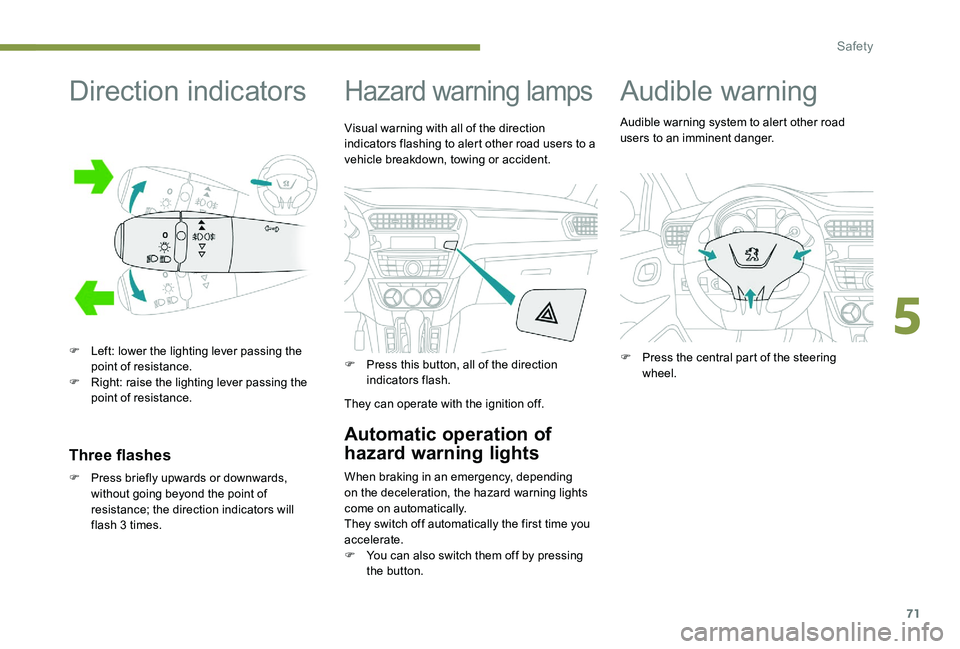
71
Direction indicators
F Left: lower the lighting lever passing the point of resistance.
F
R
ight: raise the lighting lever passing the
point of resistance.
Three flashes
F Press briefly upwards or downwards, without going beyond the point of
resistance; the direction indicators will
flash 3 times.
Hazard warning lampsAudible warning
Audible warning system to alert other road
users to an imminent danger.
Visual warning with all of the direction
indicators flashing to alert other road users to a
vehicle breakdown, towing or accident.
F
P
ress this button, all of the direction
indicators flash.
They can operate with the ignition off.
Automatic operation of
hazard warning lights
When braking in an emergency, depending
on the deceleration, the hazard warning lights
come on automatically.
They switch off automatically the first time you
accelerate.
F
Y
ou can also switch them off by pressing
the button. F
P
ress the central part of the steering
wheel.
5
Safety
Page 74 of 306
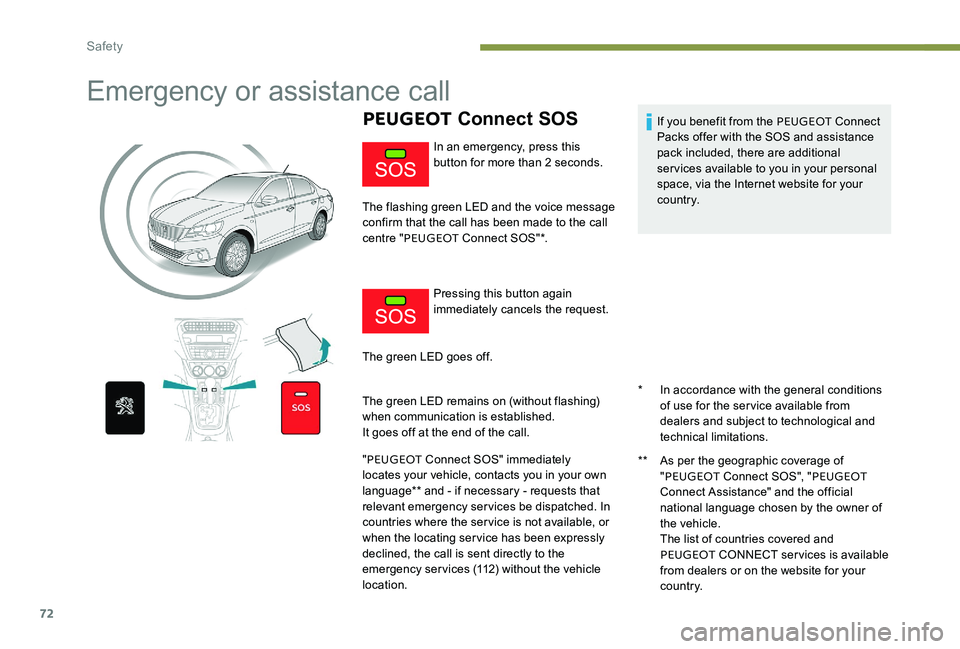
72
Emergency or assistance call
PEUGEOT Connect SOS
* In accordance with the general conditions
of use for the service available from
dealers and subject to technological and
technical limitations.
**
A
s per the geographic coverage of
" PEUGEOT Connect SOS", " PEUGEOT
Connect Assistance" and the official
national language chosen by the owner of
the vehicle.
T
he list of countries covered and
PEUGEOT CONNECT services is available
from dealers or on the website for your
c o unt r y.
In an emergency, press this
button for more than 2 seconds.
The flashing green LED and the voice message
confirm that the call has been made to the call
centre " PEUGEOT Connect SOS"*.
Pressing this button again
immediately cancels the request.
The green LED goes off.
The green LED remains on (without flashing)
when communication is established.
It goes off at the end of the call.
" PEUGEOT Connect SOS" immediately
locates your vehicle, contacts you in your own
language** and - if necessary - requests that
relevant emergency services be dispatched. In
countries where the service is not available, or
when the locating service has been expressly
declined, the call is sent directly to the
emergency services (112) without the vehicle
location. If you benefit from the PEUGEOT
Connect
Packs offer with the SOS and assistance
pack included, there are additional
services available to you in your personal
space, via the Internet website for your
c o unt r y.
Safety
Page 75 of 306
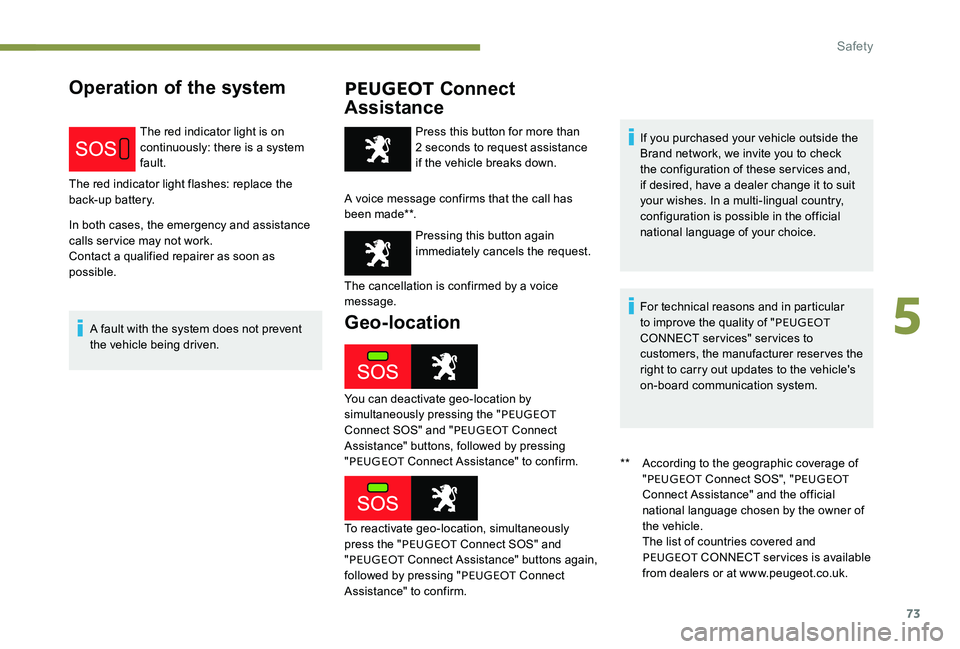
73
Operation of the systemPEUGEOT Connect
Assistance
The red indicator light is on
continuously: there is a system
fault.
The red indicator light flashes: replace the
back-up battery.
In both cases, the emergency and assistance
calls service may not work.
Contact a qualified repairer as soon as
possible.
A fault with the system does not prevent
the vehicle being driven. Press this button for more than
2 seconds to request assistance
if the vehicle breaks down.
A voice message confirms that the call has
been made**. Pressing this button again
immediately cancels the request.
The cancellation is confirmed by a voice
message.
**
A
ccording to the geographic coverage of
" PEUGEOT Connect SOS", " PEUGEOT
Connect Assistance" and the official
national language chosen by the owner of
the vehicle.
T
he list of countries covered and
PEUGEOT CONNECT services is available
from dealers or at www.peugeot.co.uk.
Geo-location
You can deactivate geo-location by
simultaneously pressing the " PEUGEOT
Connect SOS" and " PEUGEOT Connect
Assistance" buttons, followed by pressing
" PEUGEOT Connect Assistance" to confirm.
To reactivate geo-location, simultaneously
press the " PEUGEOT Connect SOS" and
" PEUGEOT Connect Assistance" buttons again,
followed by pressing " PEUGEOT Connect
Assistance" to confirm. If you purchased your vehicle outside the
Brand network, we invite you to check
the configuration of these services and,
if desired, have a dealer change it to suit
your wishes. In a multi-lingual country,
configuration is possible in the official
national language of your choice.
For technical reasons and in particular
to improve the quality of "
PEUGEOT
CONNECT services" services to
customers, the manufacturer reserves the
right to carry out updates to the vehicle's
on-board communication system.
5
Safety
Page 76 of 306
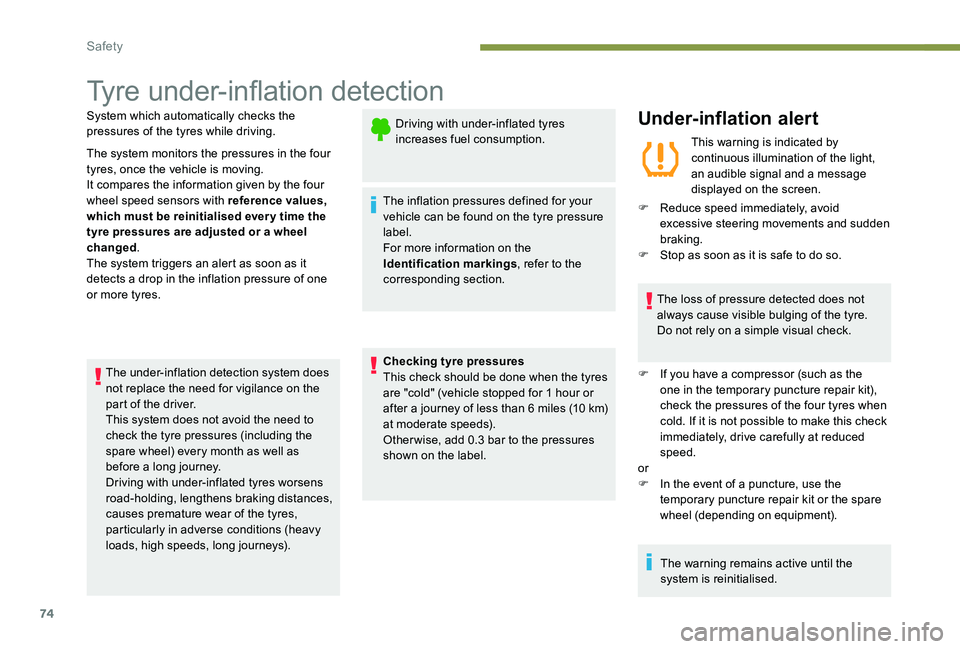
74
Tyre under-inflation detection
System which automatically checks the
pressures of the tyres while driving.
The system monitors the pressures in the four
tyres, once the vehicle is moving.
It compares the information given by the four
wheel speed sensors with reference values,
which must be reinitialised ever y time the
tyre pressures are adjusted or a wheel
changed.
The system triggers an alert as soon as it
detects a drop in the inflation pressure of one
or more tyres.Under-inflation alert
The under-inflation detection system does
not replace the need for vigilance on the
part of the driver.
This system does not avoid the need to
check the tyre pressures (including the
spare wheel) every month as well as
before a long journey.
Driving with under-inflated tyres worsens
road-holding, lengthens braking distances,
causes premature wear of the tyres,
particularly in adverse conditions (heavy
loads, high speeds, long journeys). Driving with under-inflated tyres
increases fuel consumption.
The inflation pressures defined for your
vehicle can be found on the tyre pressure
label.
For more information on the
Identification markings , refer to the
corresponding section.
Checking tyre pressures
This check should be done when the tyres
are "cold" (vehicle stopped for 1 hour or
after a journey of less than 6 miles (10 km)
at moderate speeds).
Other wise, add 0.3 bar to the pressures
shown on the label. This warning is indicated by
continuous illumination of the light,
an audible signal and a message
displayed on the screen.
F
R
educe speed immediately, avoid
excessive steering movements and sudden
braking.
F
S
top as soon as it is safe to do so.
The loss of pressure detected does not
always cause visible bulging of the tyre.
Do not rely on a simple visual check.
F I f you have a compressor (such as the
one in the temporary puncture repair kit),
check the pressures of the four tyres when
cold. If it is not possible to make this check
immediately, drive carefully at reduced
speed.
or
F
I
n the event of a puncture, use the
temporary puncture repair kit or the spare
wheel (depending on equipment).
The warning remains active until the
system is reinitialised.
Safety
Page 77 of 306
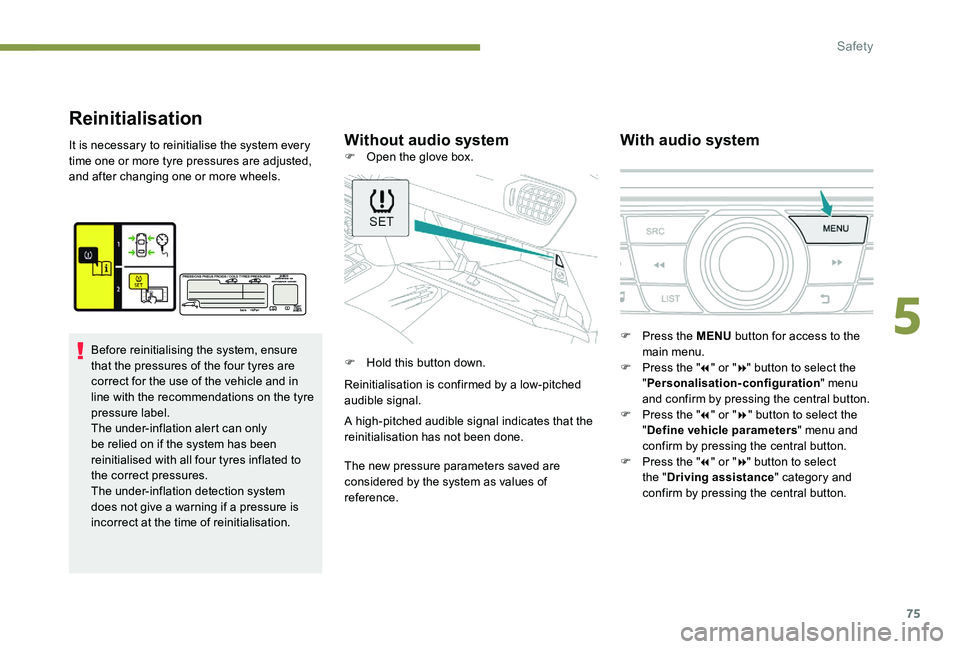
75
Reinitialisation
Without audio systemWith audio systemIt is necessary to reinitialise the system every
time one or more tyre pressures are adjusted,
and after changing one or more wheels.
Before reinitialising the system, ensure
that the pressures of the four tyres are
correct for the use of the vehicle and in
line with the recommendations on the tyre
pressure label.
The under-inflation alert can only
be relied on if the system has been
reinitialised with all four tyres inflated to
the correct pressures.
The under-inflation detection system
does not give a warning if a pressure is
incorrect at the time of reinitialisation. F
O pen the glove box.
F
H
old this button down.
Reinitialisation is confirmed by a low-pitched
audible signal.
A high-pitched audible signal indicates that the
reinitialisation has not been done.
The new pressure parameters saved are
considered by the system as values of
reference. F
P
ress the MENU button for access to the
main menu.
F
P
ress the "7" or " 8" button to select the
" Personalisation-configuration " menu
and confirm by pressing the central button.
F
P
ress the "7" or " 8" button to select the
" Define vehicle parameters " menu and
confirm by pressing the central button.
F
P
ress the "7" or " 8" button to select
the " Driving assistance " category and
confirm by pressing the central button.
5
Safety
Page 78 of 306
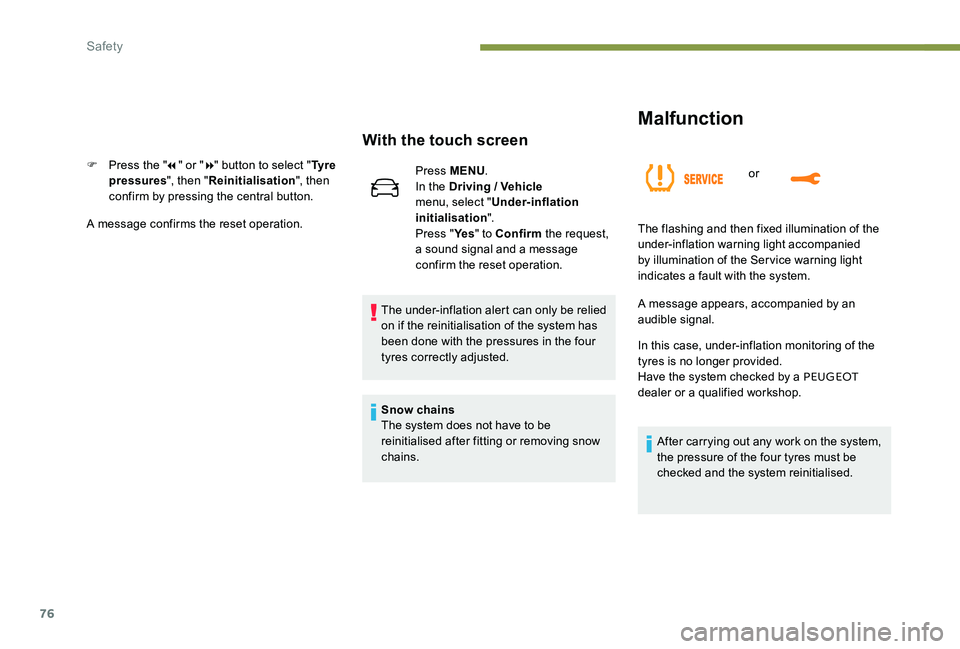
76
Malfunction
or
With the touch screen
F Press the "7" or " 8" button to select " Ty r e
pressures ", then "Reinitialisation ", then
confirm by pressing the central button.
A message confirms the reset operation. Press MENU
.
In the Driving / Vehicle
menu, select "
Under-inflation
initialisation ".
Press " Ye s" to Confirm the request,
a sound signal and a message
confirm the reset operation.
The under-inflation alert can only be relied
on if the reinitialisation of the system has
been done with the pressures in the four
tyres correctly adjusted.
Snow chains
The system does not have to be
reinitialised after fitting or removing snow
chains. The flashing and then fixed illumination of the
under-inflation warning light accompanied
by illumination of the Service warning light
indicates a fault with the system.
A message appears, accompanied by an
audible signal.
In this case, under-inflation monitoring of the
tyres is no longer provided.
Have the system checked by a PEUGEOT
dealer or a qualified workshop.
After carrying out any work on the system,
the pressure of the four tyres must be
checked and the system reinitialised.
Safety
Page 79 of 306
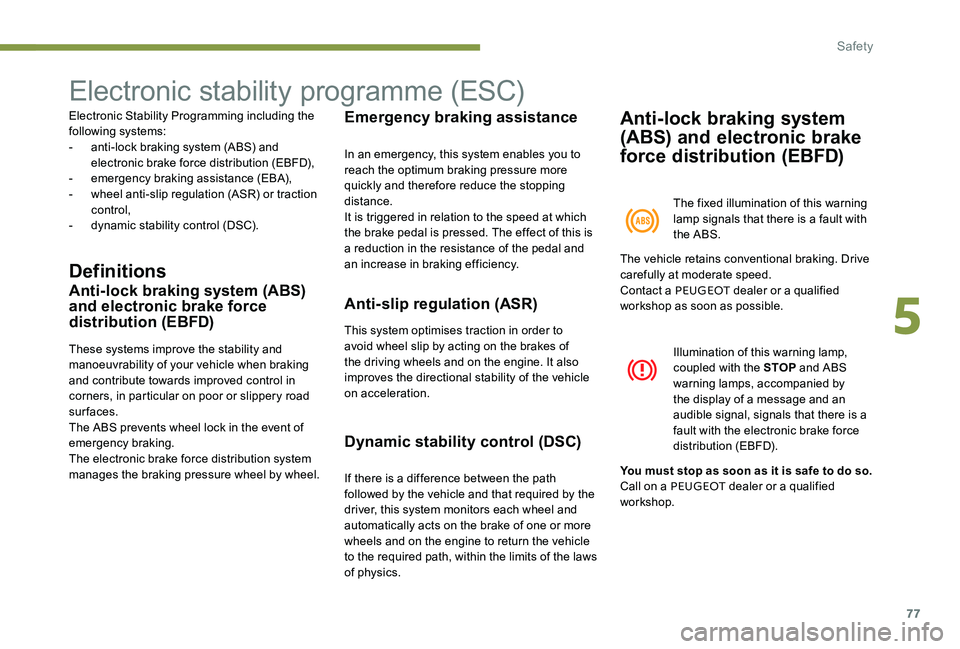
77
Electronic stability programme (ESC)
Electronic Stability Programming including the
following systems:
-
a
nti-lock braking system (ABS) and
electronic brake force distribution (EBFD),
-
em
ergency braking assistance (EBA),
-
w
heel anti-slip regulation (ASR) or traction
control,
-
d
ynamic stability control (DSC).
Definitions
Anti-lock braking system (ABS)
and electronic brake force
distribution (EBFD)
These systems improve the stability and
manoeuvrability of your vehicle when braking
and contribute towards improved control in
corners, in particular on poor or slippery road
surfaces.
The ABS prevents wheel lock in the event of
emergency braking.
The electronic brake force distribution system
manages the braking pressure wheel by wheel.
Emergency braking assistance
In an emergency, this system enables you to
reach the optimum braking pressure more
quickly and therefore reduce the stopping
distance.
It is triggered in relation to the speed at which
the brake pedal is pressed. The effect of this is
a reduction in the resistance of the pedal and
an increase in braking efficiency.
Anti-slip regulation (ASR)
This system optimises traction in order to
avoid wheel slip by acting on the brakes of
the driving wheels and on the engine. It also
improves the directional stability of the vehicle
on acceleration.
Dynamic stability control (DSC)
If there is a difference between the path
followed by the vehicle and that required by the
driver, this system monitors each wheel and
automatically acts on the brake of one or more
wheels and on the engine to return the vehicle
to the required path, within the limits of the laws
of physics.
Anti-lock braking system
(ABS) and electronic brake
force distribution (EBFD)
The fixed illumination of this warning
lamp signals that there is a fault with
the ABS.
The vehicle retains conventional braking. Drive
carefully at moderate speed.
Contact a PEUGEOT dealer or a qualified
workshop as soon as possible.
Illumination of this warning lamp,
coupled with the STOP and ABS
warning lamps, accompanied by
the display of a message and an
audible signal, signals that there is a
fault with the electronic brake force
distribution (EBFD).
You must stop as soon as it is safe to do so.
Call on a PEUGEOT dealer or a qualified
workshop.
5
Safety
Page 80 of 306
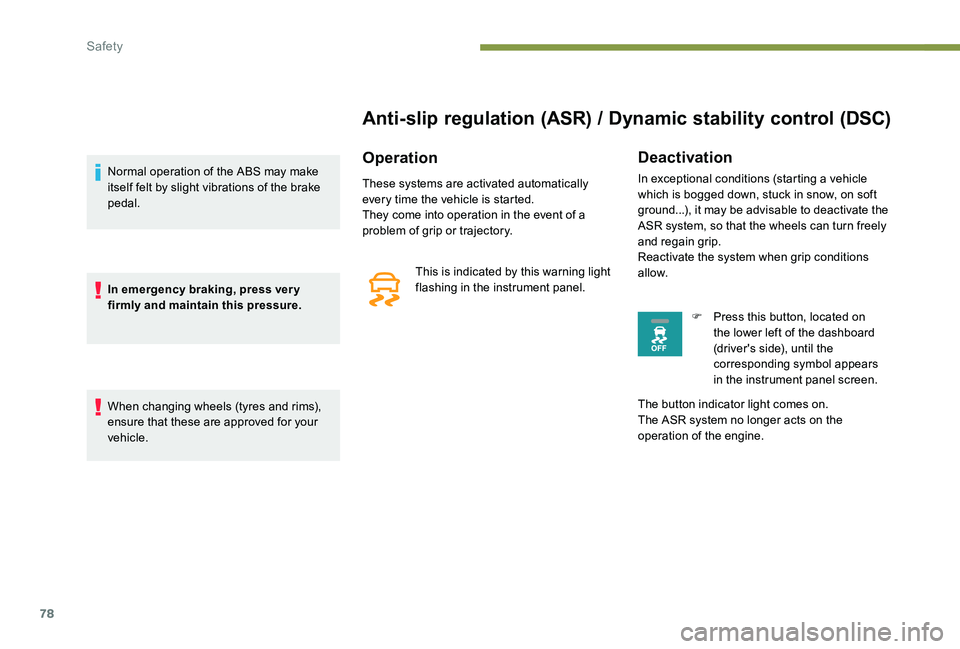
78
Anti-slip regulation (ASR) / Dynamic stability control (DSC)
Operation
These systems are activated automatically
every time the vehicle is started.
They come into operation in the event of a
problem of grip or trajectory.
Deactivation
In exceptional conditions (starting a vehicle
which is bogged down, stuck in snow, on soft
ground...), it may be advisable to deactivate the
ASR system, so that the wheels can turn freely
and regain grip.
Reactivate the system when grip conditions
allow.F
P
ress this button, located on
the lower left of the dashboard
(driver's side), until the
corresponding symbol appears
in the instrument panel screen.
The button indicator light comes on.
The ASR system no longer acts on the
operation of the engine.
This is indicated by this warning light
flashing in the instrument panel.
Normal operation of the ABS may make
itself felt by slight vibrations of the brake
pedal.
In emergency braking, press ver y
firmly and maintain this pressure.
When changing wheels (tyres and rims),
ensure that these are approved for your
vehicle.
Safety